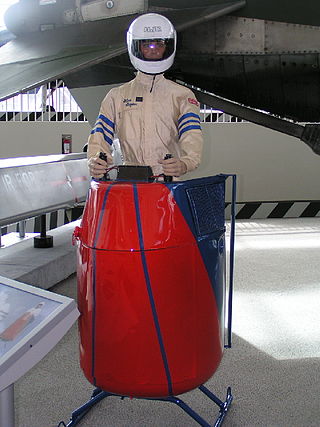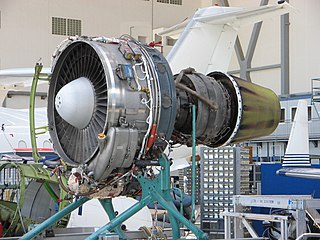
The Pratt & Whitney JT3D is an early turbofan aircraft engine derived from the Pratt & Whitney JT3C. It was first run in 1958 and was first flown in 1959 under a B-45 Tornado test aircraft. Over 8,000 JT3Ds were produced between 1959 and 1985. Most JT3D engines still in service today are used on military aircraft, where the engine is referred to by its US military designation of TF33.

The Pratt & Whitney J75 is an axial-flow turbojet engine first flown in 1955. A two-spool design in the 17,000 lbf (76 kN) thrust class, the J75 was essentially the bigger brother of the Pratt & Whitney J57 (JT3C). It was known in civilian service as the JT4A, and in a variety of stationary roles as the GG4 and FT4.

The Williams X-Jet, created by Williams International, was a small, single-person, light-weight, Vertical Take Off and Landing (VTOL) aircraft powered by a modified Williams F107 turbofan aircraft engine — designated WR-19-7 — after some minor modifications. The vehicle was nicknamed "The Flying Pulpit" for its shape. It was designed to carry one operator and to be controlled by leaning in the direction of desired travel and by modulating engine output power. It could move in any direction, accelerate rapidly, hover and rotate on its axis, stay aloft for up to 45 minutes and travel at speeds up to 60 miles per hour (97 km/h). It was evaluated by the United States Army in the 1980s, but was deemed inferior to the capabilities of helicopters and small, uncrewed aircraft, and so the development of the X-Jet was discontinued.

The Pratt & Whitney J52 is an axial-flow dual-spool turbojet engine originally designed for the United States Navy, in the 40 kN class. It powered the A-6 Intruder and the AGM-28 Hound Dog cruise missile. As of 2021 the engine was still in use in models of the A-4 Skyhawk.

The Williams FJ44 is a family of small, two-spool, turbofan engines produced by Williams International for the light business jet market. Until the recent boom in the very light jet market, the FJ44 was one of the smallest turbofans available for civilian applications. Although basically a Williams design, Rolls-Royce was brought into the project at an early stage to design, develop, and manufacture an air-cooled high-pressure (HP) turbine for the engine. The FJ44 first flew on July 12, 1988 on the Scaled Composites/Beechcraft Triumph aircraft.

The Williams FJ33 is an American family of turbofan jet engines intended for use in very light jet aircraft. The FJ33 is a scaled-down version of the FJ44 engine. The FJ33-5A is the latest version certified in June 2016.

The CFE CFE738 is a small turbofan engine aimed at the business/commuter jet market manufactured by the CFE Company, and is used on the Dassault Falcon 2000.

The NK-8 was a low-bypass turbofan engine built by the Kuznetsov Design Bureau, in the 90 kN (20,000 lbf) thrust class. It powered production models of the Ilyushin Il-62 and the Tupolev Tu-154A and B models.

The Lycoming ALF 502/LF 507 is a geared turbofan engine produced by Lycoming Engines, AlliedSignal, and Honeywell Aerospace. The U.S. military designation for the ALF 502 is YF102.

The Turbomeca Aubisque was a small turbofan engine designed and produced by Turbomeca in the 1960s. Its only application was the Saab 105 military trainer aircraft as the RM9. The engine is named after the Col d'Aubisque in the Pyrenees mountains, in line with company tradition.

The Williams F112 is a small turbofan engine made by Williams International designed to power cruise missiles. It has been used as the powerplant for the AGM-129 Advanced Cruise Missile and the AGM-86B advanced cruise missile, as well as the experimental X-36 and X-50.

The General Electric CF700 is an aft-fan turbofan development of the CJ610 turbojet. The fan blades are an extension of the low-pressure turbine blades.

The Williams F121 is a small turbofan engine designed for use in the AGM-136 Tacit Rainbow anti-radiation cruise missile.
The Teledyne CAE F106 was a small American turbofan engine developed to power cruise missiles.

The Microturbo TRI 60 is a small, expendable turbojet engine developed for use in cruise missiles, target drones, and other small unmanned air vehicles. Variants of this engine produce from 3.5 to 5.3 kN of thrust. The engine first ran in 1974.

The Teledyne CAE J402 is an American small turbojet engine. Several variants have been developed to power unmanned air vehicles such as missiles and target drones. Developed in the 1970s for the Harpoon anti-ship missile, the J402 was the first jet engine to be designed as a "wooden round", meaning that the engine had to be able to sit for long periods without maintenance or inspection and work right away.
The Kaman KSA-100 SAVER is an American aircraft-stowable gyroplane escape device designed and built by the Kaman Aerospace Corporation for the United States Navy. Designed to be used in naval combat aircraft to deploy as part of the ejection sequence, only one was built and it did not enter service. It was the first jet-powered gyroplane.
The Packard XJ49 was the first U.S. designed turbofan aircraft engine, and was developed by the Packard Motor Co. in the 1940s.

The Turbomeca Arbizon is a small turbojet engine used to power the Otomat anti-shipping missile. Developed from the Turbomeca Turmo the Arbizon was first made public in 1970 by the French manufacturer Turbomeca, by 1978 the engine had been improved to produce just over 3.5 kN thrust (800 lbf) with a stated service life of 30 hours.
The Teledyne CAE F408 is an American turbofan engine developed for a number of UAVs, drones, and cruise missiles in the late 1980s.
















